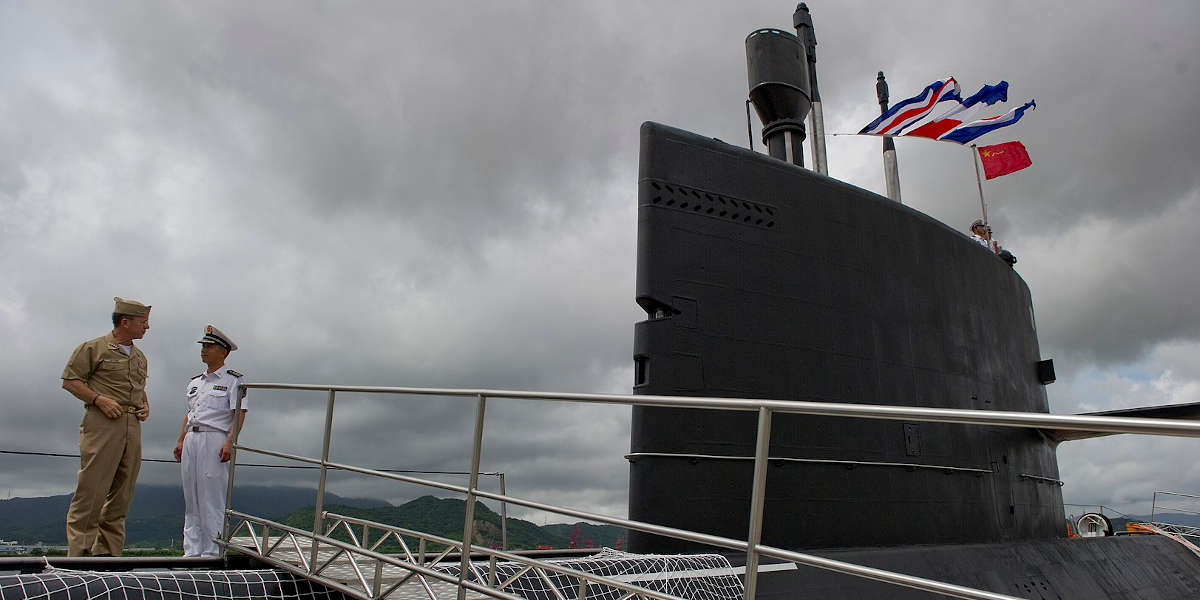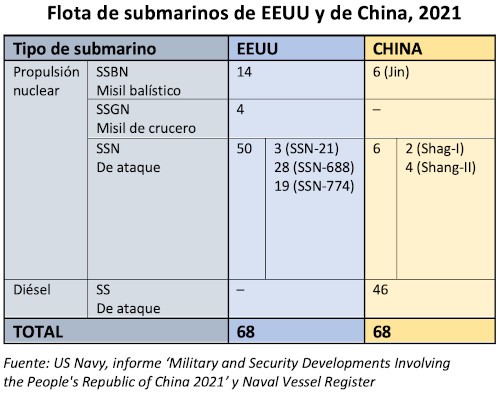In the picture
Chinese submarine class Yuan, visited by a US Navy commander in Zhoushan harbour in 2011 [US Navy].
The Chinese navy's B progress is also being made in the submarine fleet. Although the US Navy has already fallen behind its Chinese counterpart in issue of ships, the superiority of the US naval force is still clear: not only in terms of aircraft carriers and their battle groups - something that, in any case, the Chinese are supposed to be able to match in time - but also in the specific field of submarine warfare, where the US has a technological advantage that Beijing may find somewhat more difficult to catch up with. But it is enough for China to populate the seas around it with submarines to try to keep the sluggish Americans at bay. The development of quieter Chinese submarines may lead to the same Cold War 'game' popularised by "The Hunt for Red October".
The Pacific Ocean separates Asia and America and is the privileged, though by no means unique, stage for the rivalry between their respective great powers. China's emergence is also leading to a naval rivalry that is turning what was historically only a land power into a maritime power. After 25 years of modernisation of its armed forces, the People's Liberation Army Navy has overtaken the US Navy at issue .
In its latest report on the military capabilities of the People's Republic of China, the Pentagon attributed to its rival a battle fleet of 355 ships (including submarines) by the end of 2021, while the US fleet currently stands at 295 vessels, according to the Vessel Naval Register of the department Defence. agreement And the difference will increase, since, according to the US estimates, the Chinese could reach 420 ships by 2025 and 460 by 2030, while in the US the Pentagon has not yet fully achieved the political commitment to reach the 400 it is aiming for.
The issue total number of warships is certainly not the best way to contrast the military capabilities of the two powers, in a comparison in which, at least for the time being and certainly for some time to come, the US maintains its superiority not only in tonnage, but also in firepower and technological sophistication. It is often cited, for example, that compared to 11 US aircraft carriers, China has only two (a third is under construction). But US dominance also takes the form of subject of submarines, although by the end of 2021 the two countries had the same issue number of units, 68, from agreement with the Pentagon.
The US Defence report analysing China's military capabilities specifies that the People's Liberation Army Navy has placed a "high priority" on modernising its submarine fleet. However, "its structural strength continues to grow modestly as it matures its force, integrates new technologies and expands its shipyards". By this count, China has six nuclear-powered ballistic missile submarines, six nuclear-powered attack submarines and 46 diesel-powered attack submarines. The Pentagon believes China will remain between 65 and 70 submarines throughout this decade, simply by replacing some older units with more advanced ones.
While the bulk of China's submarine fleet is diesel-powered, all US submarines are nuclear-powered. The Navy has 14 ballistic missile submarines (SSBN-726) and 4 guided missile submarines (SSGN-726). The other 50 are attack submarines (3 SSN-21s, 28 SSN-688s and 19 SSN-774s).
When comparing the two forces, one must also take into account other aspects that are not strictly speaking Materials or technological, such as the fact that China has no experience in global maritime operations, with an ongoing deployment and resupply capability that is still very deficient. But while this prevents it from undertaking ambitious operations beyond its coastal borders for the time being, it does not prevent it from already posing a serious threat to nearby countries such as Taiwan. Thus, in relation to that island, China would be fully capable of deploying its massive number of ships in a short amount of time before the Americans could show up in sufficient force to deal with status, as the IISS points out.
Ghost Fleet, a novel that has been studied in US war schools for the past few years, begins with the theme of disabling the US's current submarine superiority and analyses the coming war between Washington and Beijing. The book argues that to defuse the US naval danger, China first needs to knock out its rival's most advanced submarines. That is how it could take Taiwan and also defeat the power that was once described as 'indispensable'.


